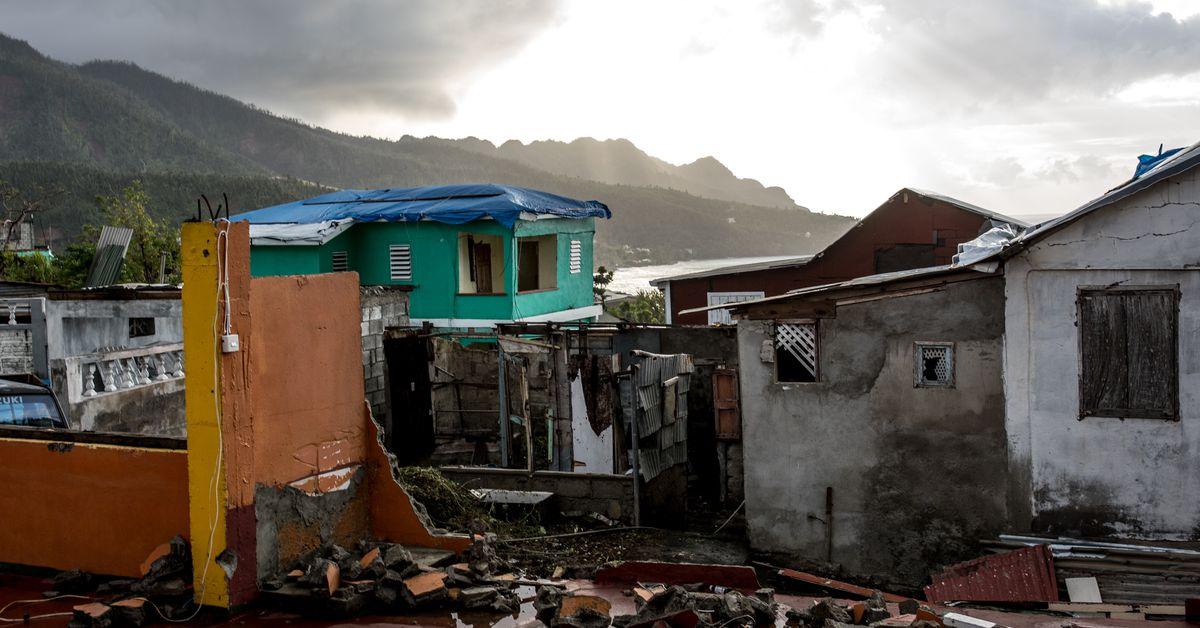This tiny Caribbean country shows why early warnings are an essential climate change adaptation.


WOTTEN WAVEN, Dominica — This lush, leafy village of 200 residents, known for its hot springs, is less than 6 miles from the shore, but when Hurricane Maria battered the tiny Caribbean island of Dominica in 2017 with winds reaching 160 miles per hour, the residents here were cut off from the rest of the world for weeks.
Though regional forecasts showed that a storm was brewing a day before landfall, many people in the region had no idea that it would turn into a monster. Maria erupted from Category 1 strength to Category 5 in just 15 hours. The Dominican government issued a public advisory over radio, text message, and social media warning of the approaching storm’s sudden strength just 1 hour and 15 minutes ahead of its landfall. Many residents without radios, phones, or computers didn’t get a warning at all.
Dominica is a rocky, jungle-covered island with about 70,000 residents, and Wotten Waven is nestled in the caldera of one of its nine volcanoes. Getting there from the capital Roseau on the coast requires driving up and down stomach-churning switchback roads. When Maria’s high winds and heavy rain quickly caused water, mud, and downed trees to block the few roads into the village, it meant help couldn’t get in and residents couldn’t get out.
It also cut off phone and internet access to the village, so when a resident had a medical emergency after the storm, a local hobbyist stepped in. “An amateur radio operator used his handheld radio to call headquarters,” said Clement Pierre-Louis, the deputy chair for community disaster response in Wotten Waven. “They sent a helicopter, picked him up, took him to the hospital in town, and immediately he was flown overseas, where he had surgery for a heart attack.”
:no_upscale()/cdn.vox-cdn.com/uploads/chorus_asset/file/24944996/DSC08116.jpeg)
Maria ultimately killed 65 people on the island, damaged more than 90 percent of homes, and caused $1.3 billion in damages, equal to 224 percent of the country’s GDP. Maria continues to haunt Dominicans as many still live in homes damaged by the storm. But it’s also given residents more resolve to prepare for future calamities, deploying more sophisticated tools as well as some traditional methods — from real-time weather stations to conch shells — to predict and communicate dangers.
Recent extreme weather events continue to reveal the dangers of inadequate warnings, and not just for small island states. The wildfire on Maui amid a severe drought this past August killed 97 people. It was the deadliest wildfire in the US in more than a century, in part because the fire spread so quickly and because the emergency warning systems on the island didn’t sound. A sudden storm in Libya this month killed close to 4,000 people as it burst dams and triggered flash floods, leaving residents little time to get to safety. And Hurricane Ian last year became the deadliest storm to hit Florida since 1935 when it killed at least 149 people. Ian rapidly intensified and changed course before landfall, so evacuation alerts were issued too late for some residents.
Yet over the course of the last century, disaster fatalities in general declined, despite more frequent weather extremes and growing populations. According to the World Meteorological Organization (WMO), the number of disasters over the last 50 years has increased fivefold, but the number of deaths has fallen by almost two-thirds.
Better predictions and warnings about impending catastrophes are a huge driver of this trend, and international aid groups are hoping to use these tools to drive down deaths further. “Just 24 hours’ notice of an impending hazardous event can cut the ensuing damage by 30 percent,” Petteri Taalas, the secretary-general of the WMO, wrote in a report last year.
But one-third of humanity — mainly in developing countries and in small island states — does not have adequate early warning coverage, according to the United Nations. Dominica is now part of a $3.1 billion UN campaign launched last year to ensure that everyone in the world is protected by a disaster early warning system by 2027. For island countries and remote communities with little room to retreat and few resources to fall back on, these systems are even more critical.
:no_upscale()/cdn.vox-cdn.com/uploads/chorus_asset/file/24945108/PXL_20230516_193510268.jpeg)
Across Dominica, the government, development banks, nonprofits, and ordinary residents are working to ensure that no one is caught off-guard when the next cyclone spools up, becoming a laboratory whose findings will inform the 40 percent of humanity that lives within 60 miles of a coastline.
Still, with average temperatures rising, many disasters are reaching greater scales and into regions where humanity has never experienced them before. Warmer air is making hurricanes dish out more rain. Hotter water fuels sea level rise, leading to more destructive storm surges. “We know for sure with climate change, things are going to get a lot worse. And we’ve got to prepare for the worst,” said Rudolph George, a disaster coordinator in Wotten Waven.
Despite vast improvements in weather forecasting, recent disasters have shown intense wind, rain, waves, and heat can still catch people by surprise. More people are living in vulnerable areas too. And when a hurricane or wildfire is bearing down, a warning is only the first step; people need the resources to act on those warnings and to recover in the aftermath in order to save lives. Dominica is aiming to become a climate-resilient nation, but the true test of its warning system will be the next major hurricane, and it’s only a matter of time before the next one lands on its shore.
Dominica is preparing for the next major hurricane, but is still reeling from the last one
Warning people about impending disasters in a country like Dominica requires tracking multiple threats and deploying many different communication strategies.
Dominica has 365 rivers, so when a tropical storm rolls in, fast-rising water levels are often an early sign of floods and mudslides in a region. A big part of Dominica’s revamped early warning system is deploying rain gauges and water level monitors throughout the island and teaching local response managers to interpret the data. Working with the World Bank, Dominica recently inaugurated 34 hydrology and meteorology stations to get more precise local forecasts.
“These were constructed to allow Dominica to access real-time weather information, and document it and transmit it to the Met Services Office that can then feed into a potential early warning system,” said Mary Boyer, a senior disaster risk management specialist at the World Bank’s disaster and recovery division. “Until the system was put in place, they were relying on Guadeloupe for weather information, and other French islands.”
The next challenge is conveying the potential threats to the community and giving them practical advice. “Not everyone understands the jargon of the weather report,” said Sandra Charter-Rolle, director-general of the Dominica Red Cross.
:no_upscale()/cdn.vox-cdn.com/uploads/chorus_asset/file/24945023/Redcross_Breifing_1.jpeg)
And when an emergency does occur, towns and villages send signals over multiple channels — radio, text message alerts, social media. “In some communities, they will use the church bells, they will use the conch shells, something that will alert the residents because not everybody can listen to the radio, or even have social media,” Charter-Rolle said.
In Wotten Waven, residents formalized an ad hoc system of knocking on doors to alert neighbors and recruited local amateur radio operators to send alerts when official channels go down, effectively deputizing the whole village as emergency responders for the next hurricane. “We deal with incidents when all other communication has failed,” said Pierre-Louis. “To prepare better for next time, we must ensure that all people are involved.”
Once a warning does go out, Dominicans can get to work. “Preparation would look like bringing boats ashore, boarding up windows, stocking up on food supplies, knowing the shelters that they can evacuate to if need be, even stocking up on medication,” said Christine John of the Dominica Red Cross.
In 2020, Dominica completed two dedicated regional emergency shelters where residents can stay during a major hurricane. The country is also upgrading its building codes in line with its neighbors in the Caribbean and ensuring that there are schools, churches, or offices in every community that can also protect people during an intense storm. The Dominican government has built more than 7,000 homes since Hurricane Maria using revised construction codes and upgraded materials, but there are still residents whose houses are missing walls or roofs from the storm.
:no_upscale()/cdn.vox-cdn.com/uploads/chorus_asset/file/24945007/PXL_20230519_214736179.jpeg)
Wotten Waven also bears some scars from the 2017 storm. “The main access road to the community is still blocked from Hurricane Maria, so they’re using bypass roads, alternative routes to get to that community,” Charter-Rolle said.
Many of Dominica’s challenges are playing out in the 48 island countries of the world, but also remote coastal regions. These places also face their own unique threats and will have to examine their own hard lessons from past disasters to stay ahead of future emergencies.
Early warning systems are only one part of reducing deaths from disasters
The foundation for reducing disaster fatalities must be built well before the catastrophe occurs, and in some cases, there is no other choice. Earthquakes, for example, are notoriously difficult to predict, like the magnitude 6.8 earthquake in Morocco earlier this month that killed at least 2,800 people. But scientists know which parts of the world are most likely to experience tremors even if they don’t know exactly when they will occur.
From this information, governments can enact building codes that allow structures to withstand quakes and save lives. Seismically active regions like Japan require building designs to withstand shaking but in some earthquake-prone places like Turkey, officials have struggled to police builders.
Similarly, researchers can monitor trends like sea level rise and ocean temperatures to figure out which areas face the greatest chances of getting hammered by a tropical cyclone or inundated by storm surge. That can yield insight into how to build a home, how tall to make a seawall, or where it makes sense to retreat. But this too depends on the money and the political will to enforce the rules.
Dominica is currently working to stabilize the main road that crosses the island to ensure access to villages further inland in the wake of a major hurricane. “The [World] Bank is working with the government to make that road the most resilient in Dominica, in terms of slope stabilization, and other bioengineering — a mix of nature-based solutions and gray infrastructure — so that road stays there for the next 50 years,” Boyer said.
:no_upscale()/cdn.vox-cdn.com/uploads/chorus_asset/file/24945010/GettyImages_989901366.jpeg)
And the need for warnings and communication doesn’t end when the ground stops shaking or when the winds die down. Oftentimes, the rubble of an earthquake or the floodwaters after a hurricane can be more dangerous than the event itself, leading to injuries and illnesses. Warning people about whether water is drinkable, where downed power lines are still energized, and where roads are impassable can prevent further casualties and route emergency services more effectively.
All the while, the global climate is changing, increasing catastrophic risks around the world. The rising concentration of greenhouse gasses in the atmosphere may be the most important early warning of the threats in store for the planet. But with most countries remaining far off course from their climate change goals, it’s a warning that many are already tuning out.
This story was supported by a grant from the United Nations Foundation.

How Wall Street helped turn poor countries into permanent debtors
- 17 hours ago

This town has 3 nuclear plants. Now, it wants another one.
- 17 hours ago
Ex-SBP governor Dr Shamshad Akhtar passes away
- 2 hours ago
Death anniversary of ex-premier Benazir Bhutto Shaheed observed
- 4 hours ago

Trump is talking about Greenland again
- 8 hours ago

Gold prices increase in Pakistan, global markets
- an hour ago

Security forces kill four Indian backed terrorists in Panjgur IBO: ISPR
- 8 hours ago
PM Shehbaz, UAE President review economic cooperation
- a day ago

Pakistan supports Saudi and UAE diplomatic efforts to ensure peace and stability in Yemen
- 11 hours ago

Pakistan condemns attempts to undermine Somalia’s sovereignty
- 5 hours ago

Taiwan rattled by 7.0 magnitude quake, no major damage reported
- an hour ago

American women want to opt out
- 17 hours ago








